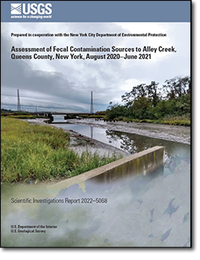Assessment of Fecal Contamination Sources to Alley Creek, Queens County, New York, August 2020–June 2021
Links
- Document: Report (28.3 MB pdf) , HTML , XML
- Data Release: USGS data release - Assessment of fecal contamination sources to Alley Creek, Queens County, New York—Results from a sediment resuspension experiment, thermal imagery, and additional sample collection, 2020–2021
- Download citation as: RIS | Dublin Core
Abstract
Suggested Citation
Fisher, S.C., Kephart, C.M., Cheung, N., and Tagliaferri, T.N., 2022, Assessment of fecal contamination sources to Alley Creek, Queens County, New York, August 2020–June 2021: U.S. Geological Survey Scientific Investigations Report 2022–5068, 35 p., https://doi.org/10.3133/sir20225068.
ISSN: 2328-0328 (online)
Study Area
Table of Contents
- Acknowledgments
- Abstract
- Introduction
- Methods
- Results
- Discussion
- Summary
- References Cited
- Appendix 1. List of Pharmaceutical Compounds Analyzed to Assess Fecal Contamination Sources to Alley Creek, Queens County, New York, August 2020–June 2021
- Appendix 2. Sediment Resuspension Data and Statistical Summary of Microbiological and Water-Chemistry Data, Alley Creek, Queens County, New York, August 2020–June 2021
| Publication type | Report |
|---|---|
| Publication Subtype | USGS Numbered Series |
| Title | Assessment of fecal contamination sources to Alley Creek, Queens County, New York, August 2020–June 2021 |
| Series title | Scientific Investigations Report |
| Series number | 2022-5068 |
| DOI | 10.3133/sir20225068 |
| Publication Date | July 20, 2022 |
| Year Published | 2022 |
| Language | English |
| Publisher | U.S. Geological Survey |
| Publisher location | Reston, VA |
| Contributing office(s) | New York Water Science Center |
| Description | Report: viii, 35 p.; Data Release |
| Country | United States |
| State | New York |
| County | Queens County |
| Other Geospatial | Alley Creek |
| Online Only (Y/N) | Y |
| Additional Online Files (Y/N) | N |


